Miscellaneous viewing – Summer 2019
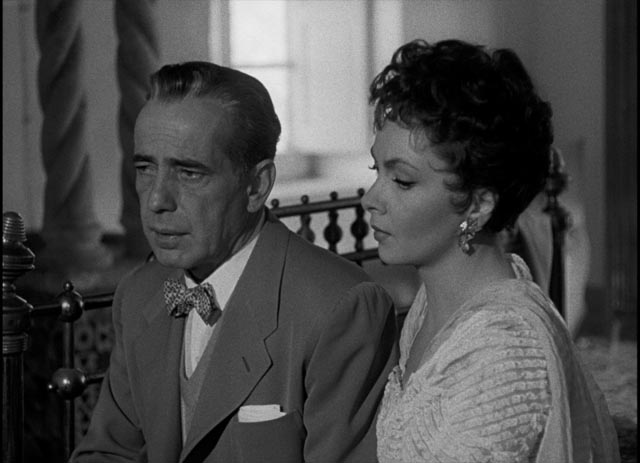
in John Huston’s Beat the Devil (1953)
Beat the Devil (John Huston, 1953)
The story of its making has tended to overshadow the intrinsic qualities of John Huston’s Beat the Devil (1953). Huston was known for taking on projects partly to provide an opportunity to travel and hang out with his friends, and Beat the Devil took him to Salerno in Italy and the sea around with long-time collaborators Humphrey Bogart and Peter Lorre to film a shaggy-dog story about a group of crooks hoping to clean up by securing mineral rights in a troubled African country. Much of the movie takes place in and around the port as they wait for their ship to set off across the Mediterranean (it’s undergoing some engine repairs).
Billy Dannreuther (Bogart) is the man with connections who is setting up the deal for Peterson (Robert Morley), Julius O’Hara (Lorre), and the murderous Major Jack Ross (Ivor Barnard). Dannreuther is having some marital problems with his wife Maria (Gina Lollobrigida) and begins a dalliance with Mrs. Gwendolen Chelm (Jennifer Jones), wife of low-level colonial bureaucrat Harry Chelm (Edward Underdown), heading to Africa to take up a post. Gwendolen is given to inflating the drama of her life with romantic fantasies and Billy provides an ideal opportunity – battered and world-weary, once rich but now fallen on harder times.
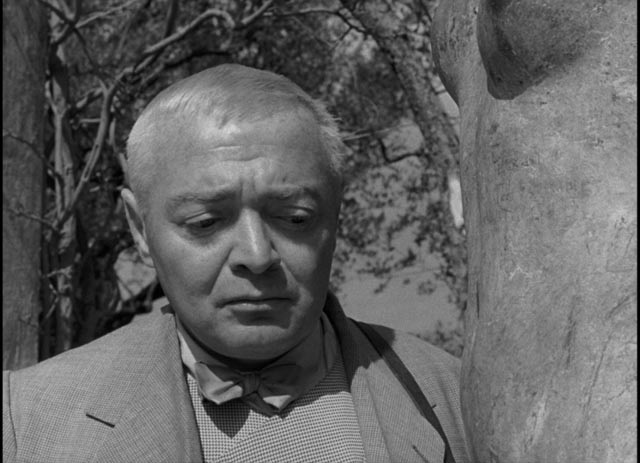
There isn’t a lot of plot, just shifting alliances, growing suspicions and misunderstandings, and an eventual sea voyage during which the characters betray and double-cross each other, causing enough friction that the ship’s often drunken captain eventually fakes a wreck in order to get everyone off in the lifeboats. They land in North Africa, are captured by the local authorities and seem in imminent danger of torture and execution … threats faked between Billy and the local police commander in order to fleece Peterson.
True, Beat the Devil is playful and relatively weightless, but it’s also a film made by people obviously enjoying themselves and each others’ company. While that kind of thing sometimes results in a hermetically sealed vessel which seems to exclude the audience from the fun, here the participants are generous; the fun is something they are consciously sharing with the audience. There’s no real suspense or tension, but there’s a great deal of wit, making it one of Huston’s most purely entertaining films.
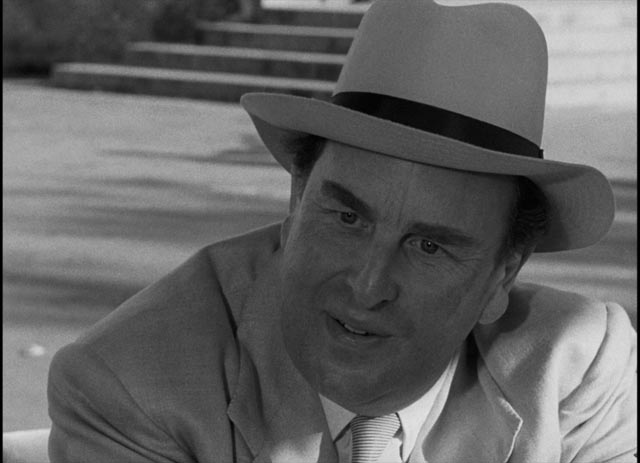
Although Truman Capote gets a co-writing credit with Huston, in an interview on Twilight Time’s Blu-ray, Alexander Cockburn (son of Claud Cockburn, author of the source novel under the name of James Helvick) says this was just a matter of publicity based on Capote’s recent prominence as the author of the well-received novel The Glass Harp (1951). Cockburn points out that much of the film’s dialogue is taken directly from his father’s novel and that Capote’s contribution was minimal. A couple of other regular Huston collaborators, Anthony Veiller and Peter Viertel, are also supposed to have worked on the script, but whoever was involved the movie has a loose, almost improvisatory feel.
The disk presents an excellent 4K restoration (via Sony) of the full-length version, rather than the shorter, restructured one with added voice-over which was for a long time the only one available. It also features a commentary from Lem Dobbs, Julie Kirgo and the late Nick Redman which I haven’t got around to listening to yet. Often considered a somewhat trifling aside in the careers of Huston and Bogart, Beat the Devil is a delightful parody of romantic adventures, which also lightly lampoons the arrogance of western imperialist attitudes.
*
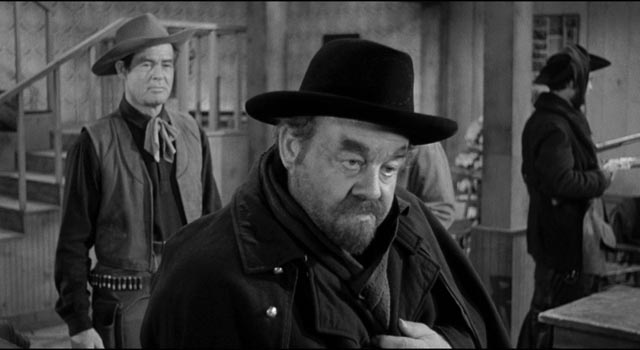
in André De Toth’s Day of the Outlaw (1959)
Day of the Outlaw (André De Toth, 1959)
Having recently watched André De Toth’s first western, Ramrod (1947), I immediately ordered a copy of the Masters of Cinema Blu-ray of what is reputedly his best film in the genre, Day of the Outlaw (1959). It was well-worth it. There are a number of things pretty much guaranteed to win me over: it stars Robert Ryan, one of my favourite actors; much of it was shot on location in a wild and obviously difficult to access mountain wilderness in the middle of winter; and it avoids many of the genre’s more obvious cliches. It begins with a familiar conflict – rancher Blaise Starrett (Ryan) is bitterly opposed to the closing of the range by newly arrived settlers who plan to farm (a trope already seen in Ramrod). He’s ready to kill to protect his access to open range. The man he’s willing to kill is Hal Crane (Alan Marshall), who is married to Helen (Tina Louise), a woman Starrett has had some kind of romantic relationship with since the couple arrived in the area a year earlier. But Helen’s pleas to spare her husband’s life are met with a hard, cold response.
Starrett and Crane are ready to face off in the local saloon, but before they can draw (with the certainty that Starrett will kill Crane), the doors burst open and a ragged and dangerous gang storm in and take control of the place, disarming everyone. Under the leadership of former Union army officer Jack Bruhn (Burl Ives in a powerful, understated performance) these men are riding ahead of a cavalry unit pursuing them into the mountains after a robbery. Bruhn clings to his sense of military honour and strives to maintain control of his unruly men who really want to get drunk and rape the four women who live in this tiny town. Problem is, Bruhn has a bullet in his chest and may be dying.
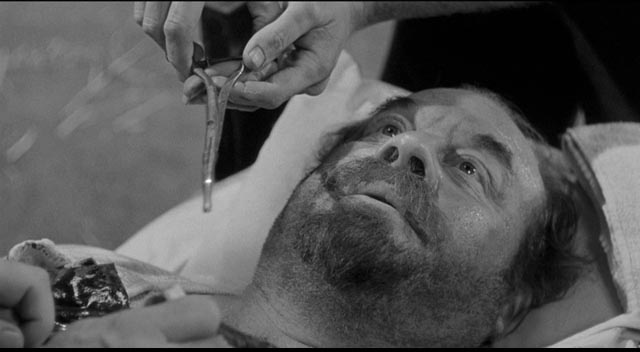
Starrett makes an uneasy alliance with Bruhn to protect the townsfolk, but as Bruhn struggles to survive being operated on by the local doctor/vet, the gang become increasingly aggressive. Starrett tries to sneak the woman out to safety, and gets beaten almost to death for his efforts. To appease his men, Bruhn agrees to let them have a party – without booze – at which they can dance with the women. This is perhaps the most remarkable and intensely uncomfortable sequence in the film, growing increasingly frenetic as the camera spins with the dancers, the men becoming more aggressive, the women more exhausted. The queasy feeling of a kind of group rape being committed on the saloon dance floor seems more violent than any potential shoot-out.
Starrett, who began as a ruggedly self-interested individual, makes a decision when it’s obvious that Bruhn will soon die, leaving his men free to wreak havoc without restraint. He offers the gang a way out, since the way they came into town is blocked by the approaching cavalry unit. He says he knows of a trail through the mountains – not an official trail, but a path he has discovered. The final act of the film is a physically gruelling trek on horseback through deep snow into a frozen dead-end. Bruhn knows there’s no way out, but he is now in unspoken alliance with Starrett to protect the people of the town. Once Bruhn is dead, the men begin turning on each other, each death giving the survivors a bigger share of the gold.
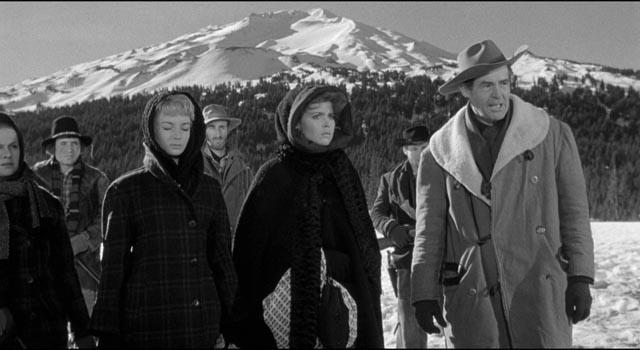
Starrett, unarmed, has no need to kill these men; he uses the harsh landscape and relentless winter weather to finish them off. The final moment of the film echoes and reverses the famous final image of John Ford’s The Searchers (1956). In the earlier film, having conquered the savage frontier, the violent man (John Wayne) has paved the way for civilization, but has no place in this new order himself. He’s left outside the cabin as the family is restored within. In Day of the Outlaw, Starrett – who begins as a violent loner – returns to the town, having risked his life to save the people, and is welcomed in as one of them. The conflict with which the story began has been completely forgotten in light of the more important imperatives of group survival. When preparing to lead the gang out to their inevitable deaths, and in all likelihood his own as well, he’s asked why he’s doing it. He replies laconically that he is simply leading bad men out of a good town.
De Toth directs with a spare style (Bertrand Tavernier in an interview on the disk calls it “Dreyerian”), maintaining a certain objective distance as he observes these characters with a kind of anthropological interest. Towards the end of the brutal fight in the snow during which Starrett is beaten by the gang on Bruhn’s orders, de Toth cuts back to a long shot down the muddy rutted street, the fighters becoming tiny figures against a looming background of snow-clad mountains, abruptly giving a context which makes these human conflicts seem small and unimportant. It’s almost a god’s-eye view; and yet for the characters these events are of absolute importance, a matter of life and death in the face of an indifferent universe.
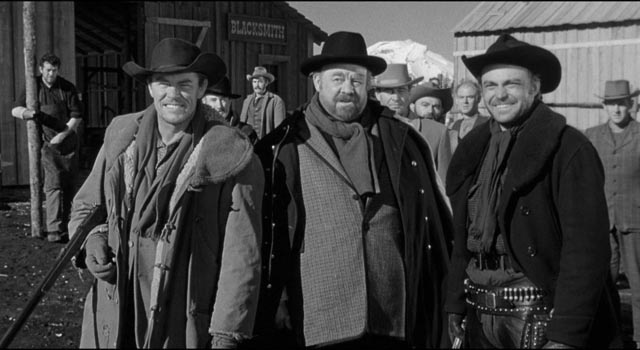
The setting for this story is visually breathtaking, the tiny town having been built months earlier in a difficult to access part of Oregon so that it would be convincingly weathered by the time winter closed in. Most of the interiors were also shot on location, the town’s buildings having been fully constructed, rather than erected as mere facades. Russell Harlan’s photography brings out the harshness of the environment, with scenes filmed in fog and during real snowstorms with limited visibility and the cold revealed by the plumes of breath from men and horses alike. The ride into the mountains looks absolutely brutal, the horses struggling with each step in the deep snow.
The authenticity of this imagery makes the few shots filmed in a studio with rear projection look jarringly false – not only does the landscape get flattened by the reduction in contrast, the background plates are unstable so that the forest and mountains kind of float behind the close-ups of the actors. It’s an unfortunate visual flaw, and yet in a way these few shots serve to emphasize the absolute authenticity of the location work.
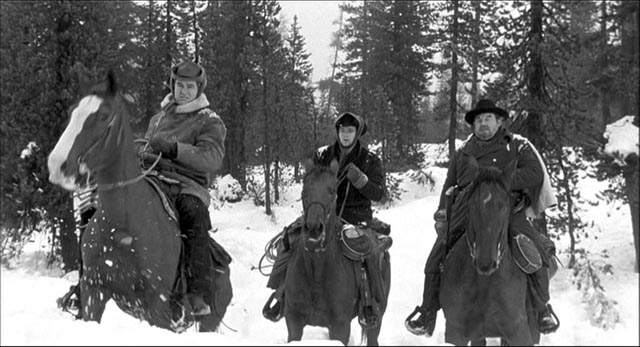
As in Ramrod, De Toth provides space in the midst of the action for strong female characters; though not quite as central here as in the earlier film, Tina Louise as Helen Crane and Venetia Stevenson (who the next year would play the ill-fated college student Nan Barlow in John Llewellyn Moxey’s The City of the Dead) as the teenage Ernine provide effective counterweight to the masculine violence. The cast is excellent, with Ryan and Ives at their best as antagonists who eventually form a largely unspoken bond in the face of more pressing issues. The outlaw gang are like a preview of the Wild Bunch; there are even a number of visual compositions which might well have influenced Peckinpah.
The Blu-ray has a richly textured image and a strong, uncompressed soundtrack. The genre-appropriate score is by Alexander Courage, best-known for his theme for the original Star Trek. Bertrand Tavernier, in a half-hour interview, is passionate about the film and about De Toth’s work in general. Until this movie and Ramrod, I was really only familiar with House of Wax and Play Dirty. Now I’ll have to start digging into De Toth’s noir movies.
*
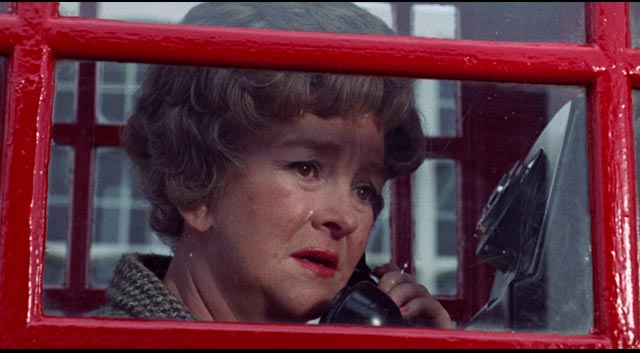
in Robert Aldrich’s The Killing of Sister George (1968)
The Killing of Sister George (Robert Aldrich, 1968)
Not being gay, I’m honestly not sure whether I should find Robert Aldrich’s The Killing of Sister George (1968) offensive. This adaptation of a play by Frank Marcus (scripted by Aldrich’s frequent collaborator Lukas Heller) obviously comes in a direct line of descent from the director’s landmark “hag horror” classics Whatever Happened to Baby Jane? (1962) and Hush … Hush, Sweet Charlotte (1964) – there’s a touch of grotesquerie about the three lead characters, but there’s also an obvious degree of empathy for those characters. Aldrich, a very muscular and masculine filmmaker, seems like an odd choice to direct a film about the interconnected lives of three lesbians, and yet Sister George is one of his best-directed movies, particularly surprising coming just a year after the ugly and artless mega-hit The Dirty Dozen … and on the heels of his long-derided Hollywood Gothic The Legend of Lylah Clare (also 1968).
Like Lylah Clare, much of Sister George is set in and around a studio and hinges on, among other things, the complicated relationship between a performer and a role. But rather than a big Hollywood soundstage, here we get a cramped BBC television studio in which an evening country-village soap is shot. The popular star of the show is June Buckridge (Beryl Reid), who plays the local nurse who rides around the countryside on her small motor bike tending to “her people”. The character is wise and filled with concern for others’ problems; the actress is a grand dame, loud, heavy-drinking and egotistical.
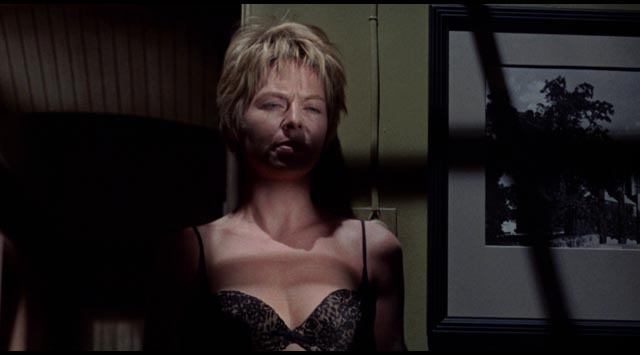
She is also a lesbian who lives with Childie (Susannah York), a damaged woman who is submissive to June’s domineering personality. Whatever has happened in her past (she had and lost a child, perhaps was a victim of rape), Childie has essentially handed herself emotionally to a stronger woman who takes pleasure in punishing her for perceived sins … sins which Childie has taken to exaggerating in order to provoke June. In particular, she implies that her boss is pursuing her sexually and that she hasn’t got the will to resist him.
It’s obvious that Childie is tired of the role being imposed on her and is perhaps pushing June to reject her, which in effect will free her. In playing her submissive role, she has to suppress her own hopes and desires (she has been writing poetry to express herself, but keeps it hidden from June who would automatically heap contempt on her efforts).
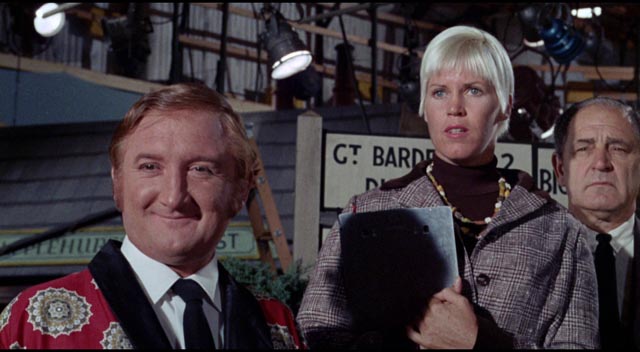
While their home life is fraying, June is also becoming insecure about her work. There are hints that she may be written out of the show; she learns that a relatively new cast member is surpassing her in audience popularity. She drinks more and more and begins to lose control. Heading home from the pub she jumps into a taxi stopped at a red light and finds it occupied by a pair of young novitiate nuns, but instead of getting back out she mauls them – and word of the offence gets back to the bosses at the BBC. Her fears are making her a liability for the corporation and the writers do indeed start to ease her out of the show.
Like many a Hollywood movie about the movies, the story hinges on a woman whose age is making her less commercially viable for producers. The difference here is the unconcealed homosexuality of the character, a rarity at the time. With the loosening of censorship in the ’60s and changing social attitudes, what had been hidden was beginning to rise to the surface. But Sister George isn’t a sensitive social issues drama like Basil Dearden’s Victim (made in 1961, when homosexuality was still illegal in Britain; legalization finally came in 1967). Sister George is a full-blown melodrama with a satirical edge. With few previous examples in popular culture, the film – like the Frank Sinatra feature The Detective, made the same year by Gordon Douglas – falls back on obvious stereotypes (butch, femme, closeted [Coral Browne’s uptight BBC executive]). What is relatively new is that it treats those stereotypes with a degree of sympathy (as did The Detective), while still not quite being able not to see these lesbian characters as “other”. It’s a transitional film, on the way to normalization and acceptance.
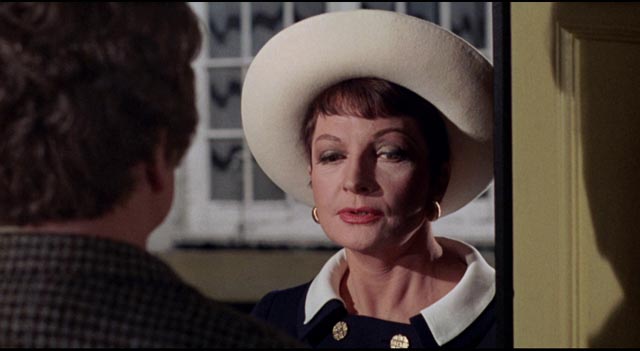
What makes The Killing of Sister George so interesting is the way it examines various layers of performance. There’s the obvious contrast between the bluff, no-nonsense country nurse George and the loud, often drunk June who takes pleasure in pushing the buttons of her co-workers as if daring them to strike back. But then within their private lives June, Childie and even Marcy Croft (Browne) exist in a constant state of performance – social convention insists that they can’t show their true selves to the world, so every aspect of their lives becomes performative. Yet those core selves can’t be entirely suppressed, so the performance becomes an exaggerated reflection of those hidden selves. In a sense, social pressure forces them into stereotypical roles which allow others to see them as not quite real and therefore more easily ignored or dismissed.
Needless to say, the cast is excellent with Reid tearing into her part the way Bette Davis did in Whatever Happened to Baby Jane?. The mix of location shooting in London and studio work in Hollywood gives the production a rich visual texture, with somewhat claustrophobic interiors to amplify the tensions between the characters.
The image on Kino’s Blu-ray, from a 4K scan of the original negative, is excellent. And there are two commentaries – one from the always interesting Kat Ellinger, the other from David Del Valle and Michael Verrati – plus a very brief interview with camera operator Brian West.
Comments